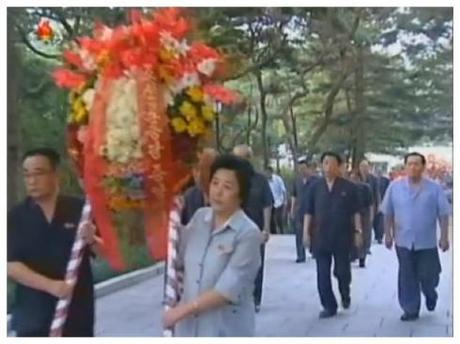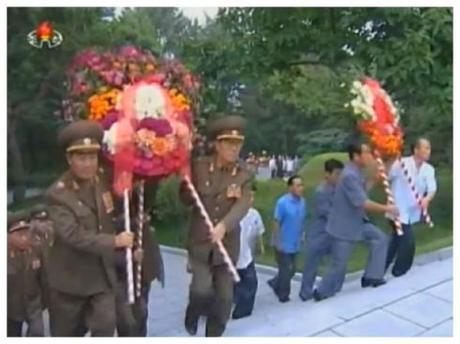
Floral wreath from Kim Jong Un (L) placed beside the grave of his great-grandfather Kim Po Hyon in Pyongyang on 19 August 2013 (Photo: KCNA).
Floral wreath-laying ceremonies were held at the grave of Kim Po Hyon (1871-1955), grandfather of late DPRK President and founder Kim Il Sung (Kim Il-so’ng), in Mangyo’ngdae in Pyongyang on 19 August (Monday). Attending the wreath laying ceremonies to commemorate Kim Po Hyon’s 142nd birth anniversary were Korean Workers’ Party [KWP] Secretary and Director of the Propaganda and Agitation Department Kim Ki Nam, DPRK Vice Premier and Chairman of the State Planning Commission Ro Tu Chol, functionaries and “officials of the party and power organs, working people’s organizations, ministries and national institutions and Pyongyangites.” Among those seen carrying floral wreaths to the grave was KWP Science Education Department Director Han Kwang Bok (former DPRK Vice Premier and Minister of Electronic Industry) and Kim Il Sung Military University Chancellor VMar Kim Jong Gak (former Minister of the People’s Armed Forces). Floral wreaths were delivered on behalf of Kim Po Hyon’s great-grandson, current DPRK leader Kim Jong Un (Kim Cho’ng-u’n), the KWP Central Committee and “wreaths in the names of working people’s bodies, ministries and national institutions, educational and media institutions, party and power organs and farms in Pyongyang.”

Members of the DPRK central leadership attend a wreath laying ceremony in Pyongyang on 19 August 2013 commemorating the 142nd birth anniversary of Kim Po Hyon, grandfather of late DPRK President and founder Kim Il Sung (Photo: KCNA).

Han Kwang Bok (R), Director of the KWP Science Education Department carries a floral wreath on behalf of the Party Central Committee to the grave of Kim Po Hyon in Pyongyang on 19 August 2013 (Photo: KCTV screengrab).

VMar Kim Jong Gak (L) carries a floral wreath to the grave of Kim Po Hyon in Pyongyang on 19 August 2013 (Photo: KCNA).

Kim Il Sung’s paternal grandparents Kim Po Hyon (L) Ri Po Ik (C) and KIS with his grandparents and family members (Photos: NKLW Archives).
Kim Po Hyon was father of Kim Hyong Jik (Kim Hyo’ng-ch’ik), Kim Il Sung’s father. KIS’ memoir chronicles aspects of his grandfather’s hardscrabble life and depicts Kim Po Hyon as encouraging the anti-Japanese activities of Kim Hyong Jik and later, Kim Il Sung. Unlike the Kim Hyong Jik narrative, there is very little factualization about the lives of Kim Po Hyon or his wife, Ri Po Ik (1876-1959). According to the official folklore, after his return to the country in 1945, Kim Il Sung stopped his car at the fork in an old road with one path leading to Mangyo’ngdae (and his grandparents’ home) and the other leading to the steel factory in Kangso’n. The story depicts Kim Il Sung as prioritizing the “building of a new country” over his family life; he deferred visiting his grandparents and sent an aide to Mangyo’ngdae saying “There will be be my old grandparents. You give my best regards to them.” In December 2008 late leader Kim Jong Il (Kim Cho’ng-il) visited the Ch’o'llima Steel Complex (formerly the Kangso’n Steel Mill) where, according to a Rodong Sinmun essay, he would be inspired by “third- and fourth-generation members of the revolution [who] highly raised the flames of succession to the cause of the revolution.” On the “succession [to the] cause of the revolution” the Rodong essay stated the “average age” of the successors “is 25. Average age of 25. What a heart-stirring reality this is.” KJI’s visit to the steel mill in 2008 and the subsequent rhetoric applied to the visit was a key internal moment in the early phase of Kim Jong Un’s hereditary succession.
Filed under: Central Committee, central party life, colonel general, DPRK Cabinet, Events Management Section, Finance and Accounting, Financial Planning Department, General Affairs, gsd, Guard Command, Jang Chol (State Academy of Science President), Kim Family, Kim Jong-il, Kim Jong-un, Kim Ki Nam, KJI Personal Secretariat, Korean People's Army (KPA), Korean People's Internal Security Forces, Korean Workers' Party (KWP), KPA General Political Bureau, KPA General Political Department, KPA General Propaganda Department, KPA General Staff, KPA supernumerary organizations, kpif, KWP Science and Education Department, local people's committees, Ministry of Agriculture, ministry of people's security, Ministry of the People's Armed Forces (MPAF), MPAF GPB, National Defense Commission (NDC), North Korean press, Organization and Guidance Department, party cells, Party History Institute, party life, Political Bureau, Propaganda and Agitation Department, Provincial Party Committees, Provinicial People's Committee, Ro Tu Chol, rural management committees, Secretariat, State Planning Commission (SPC), Supreme People's Assembly, VMar Kim Jong Gak, Working Organizations
